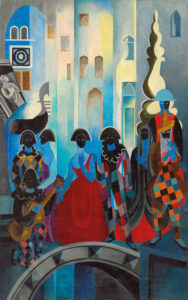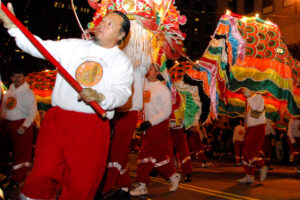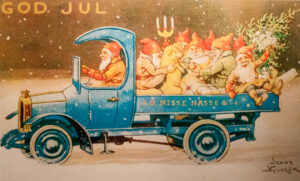It’s the First of February: Imbolc, and St. Brigid’s Day: Brigid, who bridges us from winter to spring in her subtle way. The weather may still be cold here in the Northern Hemisphere, but we find ourselves now about halfway between Midwinter Solstice and Vernal Equinox, and the acknowledgment that spring approaches is the value of St. Brigid’s Day. Spring’s first stirrings begin here.
And as it is the First of February, we’ve got a gift for you: It’s the Convivio Book of Days calendar for February. A printable PDF, as usual, so you may print it and keep it nearby to help remind you to live the ceremony of each day. The calendar is a fine companion to this blog.
Tonight, with the setting sun, St. Brigid’s Day becomes Candlemas Eve. With Candlemas, on the Second of February, Christmas and Yuletide, which have so many potential endings, do finally come to a proper close, for it is time to move on to what comes next… which is renewal, of course, and the promise of spring. Our convivial 17th-century British poet Robert Herrick reminds us that with Candlemas Eve, it is time to remove the yuletide greenery from our homes. From his poem “Ceremony Upon Candlemas Eve:”
Down with the rosemary, and so
Down with the bays and misletoe ;
Down with the holly, ivy, all,
Wherewith ye dress’d the Christmas Hall :
That so the superstitious find
No one least branch there left behind :
For look, how many leaves there be
Neglected, there (maids, trust to me)
So many goblins you shall see.
While the greenery should be removed by tonight, tradition would have us keep nativity scenes in our home through Candlemas, tomorrow. Candlemas, on the Second of February, is the day that candles are blessed in the church. It is also known as Purification Day, which harkens back to an old Hebrew tradition: forty days after the birth of a son, women would go to the temple to be purified. And there is that idea again: renewal––the same sort of renewal that Brigid brings us.
And so Mary went to the temple, for it was her tradition, and when she did, it was there that she and her infant child ran into the elders Simeon and Anna, who recognized the child as “the Light of the World.” This is the basis for the blessing of candles on this day, and the day’s lovely name (Candlemas), which is even more beautiful in other languages: la Candelaria in Spanish, la Chandeleur in French. In France, the traditional evening meal for la Chandeleur is crêpes. In Mexico, la Candelaria is a night for tamales and hot chocolate, while the procession and celebration in Puno, Peru, is typically so big, it rivals that of Carnival in Rio de Janeiro. And at sunset on Candlemas, we’ll go through the house, through every room, lighting every lamp, even for just a few minutes. My favorite song for the day, as I tell you each year around the start of February, is an old carol called “Jesus, the Light of the World.” Is it a carol for Candlemas? Who knows. Certainly the words echo those of Simeon and Anna, the elders in the temple, so as for me, I say it is.
And so this night we thank our Christmas tree and garland for their presence with us all through Christmas, and then quietly carry them out the back door and into a corner of the yard. We thank nature for the gifts she lent to us, and we return to nature what is hers. We’ll store these things these things there in the backyard, and they will become part of the habitat: a bit of fir and cedar amongst the bamboo and the palms and grasses. And when December comes around again, on the longest night, we will use what is left of the tree as fuel for our Midwinter solstice fire as we welcome down the stars and welcome back the light. I love this bit of ceremony. For us, it connects one Christmas to the next. Most importantly, we send Father Christmas off tonight and each year with respect and dignity… and with this, we are more prepared to welcome spring as we step onto the bridge that Brigid offers us.
SHOP OUR VALENTINE SALE!
At our online catalog right now use discount code LOVEHANDMADE to save $10 on your $85 purchase, plus get free domestic shipping, too. That’s a total savings of $19.95. Spend less than $85 and our flat rate shipping fee of $9.95 applies. We have many lovely new arrivals for Valentine’s Day. CLICK HERE to shop; you know we appreciate your support immensely.
COME TO THE SHOP!
Locals: the shop is open Saturdays from 11 AM to 4 PM at 1110 North G Street, Lake Worth Beach, FL 33460. And next weekend, it’s our VALENTINE MARKET: Friday evening, February 7, from 5 to 8 PM, and Saturday & Sunday, February 8 & 9, from 11 AM to 4 PM. You’ll love what we have in store for you!
Our cover star image for the February Book of Days calendar is a painting called “Carnival in Venice” by Aleksandra Ekster. Oil on canvas, 1930s [Public domain via Wikimedia Commons].




